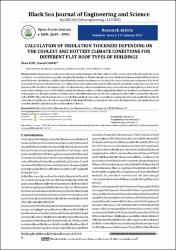| dc.contributor.author | Kon, Okan | |
| dc.contributor.author | Caner, İsmail | |
| dc.date.accessioned | 2024-02-05T15:58:35Z | |
| dc.date.available | 2024-02-05T15:58:35Z | |
| dc.date.issued | 2023 | |
| dc.identifier.issn | 2619-8991 | |
| dc.identifier.uri | https://doi.org/10.34248/bsengineering.1125983 | |
| dc.identifier.uri | https://search.trdizin.gov.tr/yayin/detay/1153506 | |
| dc.identifier.uri | https://hdl.handle.net/20.500.12462/14144 | |
| dc.description.abstract | In this study, optimum insulation thicknesses are calculated for three different flat-surfaces which are navigable terrace roof; stone-covered and soil-covered un-navigable flat roof types. The outdoor temperature, the value of January, which is the coldest month in winter, and the value of July, which is the hottest month in summer, and solar radiation, are considered together. Flat roof surfaces are considered to be stone-covered and soil-covered black painted and marble. Firstly, solar-air temperatures were determined for the winter and summer periods. Then, optimum insulation thickness calculations are made using life cycle total cost analysis. Extruded polystyrene (XPS) is accepted as the insulation material. Natural gas is used in winter and electricity in summer as an energy sources. The optimum insulation thicknesses have been calculated for five climate zones and three different roof types based on the TS 825. Then the results are compared. As a result, the optimum insulation thickness calculated considering the hottest and coldest months of the year was determined as 0.128 m in the 5th climate zone in roof one with the highest value, and as the lowest value with the 0.052 m in the 1st climate zone for roof three. | en_US |
| dc.language.iso | eng | en_US |
| dc.relation.ispartof | Black Sea Journal of Engineering and Science | en_US |
| dc.rights | info:eu-repo/semantics/openAccess | en_US |
| dc.rights | Attribution-NonCommercial 4.0 International | * |
| dc.rights.uri | https://creativecommons.org/licenses/by-nc/4.0/ | * |
| dc.subject | Flat Roof | en_US |
| dc.subject | Green Roof | en_US |
| dc.subject | Optimum Insulation Thickness | en_US |
| dc.subject | Solar-Air Temperature | en_US |
| dc.subject | TS 825 Standard | en_US |
| dc.title | Calculation of insulation thickness depending on the coolest and hottest climate conditions for different flat roof types of buildings | en_US |
| dc.type | article | en_US |
| dc.contributor.department | Balıkesir Üniversitesi | en_US |
| dc.identifier.volume | 6 | en_US |
| dc.identifier.issue | 1 | en_US |
| dc.identifier.startpage | 1 | en_US |
| dc.identifier.endpage | 9 | en_US |
| dc.relation.publicationcategory | Makale - Ulusal Hakemli Dergi - Kurum Öğretim Elemanı | en_US |
| dc.buozel | trdizinideal | en_US] |
| dc.department-temp | Balıkesir Üniversitesi, Makine Mühendisliği Bölümü, Balıkesir, Türkiye Balıkesir Üniversitesi, Makine Mühendisliği Bölümü, Balıkesir, Türkiye | en_US |
| dc.identifier.trdizinid | 1153506 | en_US |
| dc.identifier.doi | 10.34248/bsengineering.1125983 | |



















